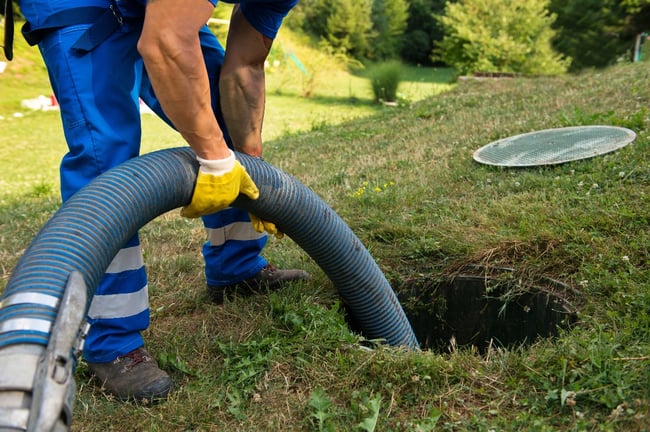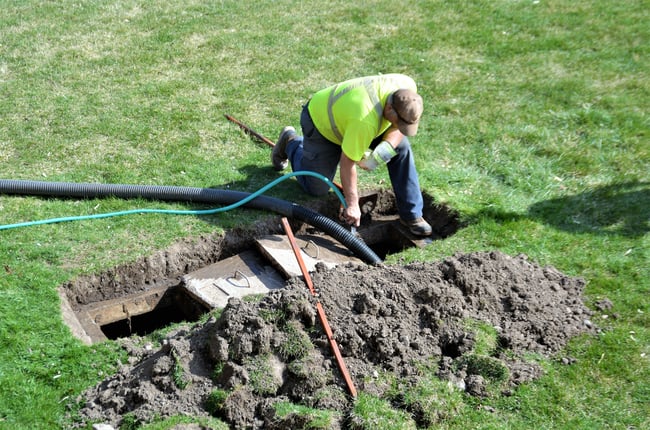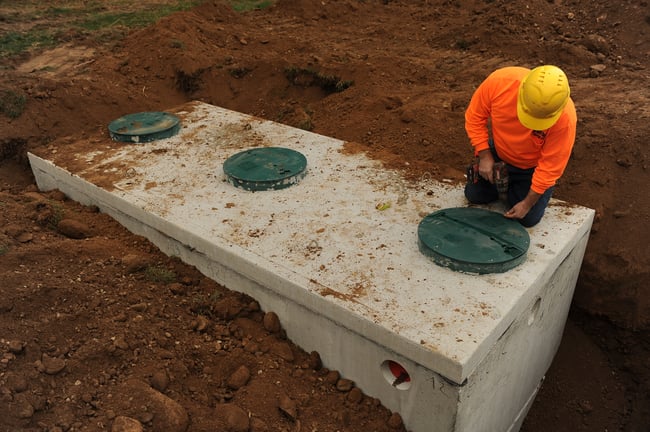How Septic Systems Work (+ Common Types of Systems)
Posted by William Heinselman on

Septic systems are used throughout the country for homes and small businesses that don’t have access to a municipal sewer system. Instead of what we’re commonly used to in cities and urban areas, septic systems serve as an alternative water treatment process right on-site.
If you’re installing a new septic system or are moving to a community that uses septic systems, then it’ll be a good idea to have a basic understanding of what they do and how they work.
Understanding Your Septic System
What is a septic system? You might know the basics: a septic system is an underground wastewater treatment system on your property.
Depending on where you live, you might have an option to connect your home to the local sewer system or use a localized septic system. In other instances, some families might be moving to an area that doesn’t have access to municipal sewers.
Septic Systems vs. Sewer Systems
Septic systems are responsible for treating wastewater on-site. In contrast, public sewer systems move untreated wastewater away from homes and businesses to a large treatment facility.
When a home uses a septic system, it is up to the homeowner to make sure that it’s properly maintained. Some homeowners prefer this for the additional independence that a septic system provides, and they can save some money when it comes to monthly expenses. While this is frequently an advantage, it’s also important to know that, according to the Environmental Protection Agency (EPA), local health departments are responsible for issuing construction and operating permits for septic systems.
With a public sewer system, the local government ensures that all components are working properly so residents have access to clean water. However, this can have a big impact on the surrounding environment as treatment facilities require a lot of energy and sometimes chemicals to ensure that the water is thoroughly filtered.
Septic systems don’t have as big of an impact on the environment. In fact, the filtration into the groundwater adds nutrients to the soil so surrounding plant life tends to thrive as a result of underground water treatment.
The Main Parts of a Septic System

Septic systems are composed of many different parts that each serve a purpose. More complex systems may require specialized parts depending on what is needed, while others are made up of a few pieces of equipment to effectively filter the wastewater. To cover the basics, let’s look at some of the main features that are common across all types of septic systems.
Drainage Pipe
This component is what connects the building to the septic tank, also called an inlet pipe. The drainage pipe is frequently made out of a long PVC pipe and moves any wastewater from toilets, showers, and sinks to the septic system.
Exit Pipe
As waste enters the septic system, water and effluent, liquid forms of waste, need to exit. These liquids are diverted to a nearby drainfield. Depending on the property, a septic system might also include a pump station to create pressure and move water out through the exit pipe.
Tank
The main component of a septic system is the tank. This is a large watertight structure that’s buried underground and away from the main building. The tank is where the treatment process begins and the waste is separated into solid, floatable matter and effluent.
The septic tank has two main compartments. The primary compartment is where the solid waste is separated from the effluent, which is stored in the outlet compartment. The partition between the two compartments prevents solids from entering the exit pipe and flowing out into the drainfield.
Drainfield
An underground system of perforated pipes, commonly referred to as a leach field, collects wastewater from your septic tank. As wastewater moves through the drain field, any pollutants that slipped through the effluent filter at the beginning of the exit pipe are removed and the remaining water is discharged back into the groundwater.
Vents
The waste that enters the septic system produces gasses, which accumulate above the water level inside of the tank. As the gas expands, it goes back through the drainage pipe and exits the septic system via vents installed on the roof of the main building.
Soil
A septic system works in conjunction with the surrounding land, so soil is important for proper water treatment. The type of soil used for your septic system plays an important role, too. When the effluent reaches the drainfield, it's important that there are microorganisms in the soil that can remove any remaining bacteria.
Without these organisms feeding on the bacteria, the septic system might not substantially filter the waste, leading to contamination of the surrounding land. If you’re unsure of the quality of the soil on your land, conduct a soil test to learn more about its qualities and what maintenance may be needed.
Types of Septic Systems
While all septic tanks are buried and function to treat wastewater, not every treatment system is the same. Depending on the type of land, amount of space, and projected usage, there are all different types of systems available. Let’s look at a few different types of septic systems used for both single homes and small communities.
Conventional
A conventional septic system is a decentralized wastewater treatment system that is typically used for small businesses or single-family homes in rural areas. These systems use a septic tank, inlet and exit pipes, and drainfields to treat wastewater that moves through the system.
The drainfield is constructed using gravel trenches to help disperse water through the surrounding soil bed. As the wastewater moves through the gravel and into the soil, it is filtered by microorganisms. Eventually, this treated water enters back into the groundwater.
Chamber
Not every property is suitable for a septic system that relies on conventional technology. So, a chamber septic system is an excellent choice for any property in need of a gravelless wastewater treatment system.
Instead of gravel, the pipes in the drainfield are encased by a chamber, oftentimes made of plastic or recycled materials. Within this chamber is a layer of soil where the treatment process continues as normal.
Mound
Mound systems use a large hill of sand to help with the distribution of treated wastewater. These systems are typically implemented in areas with high groundwater and low soil levels. Thanks to the sand mound, the drainage field is able to be elevated in comparison to conventional septic systems.
In a mound system, effluent enters the drainfield and is then filtered through the sand. A mound septic system requires more maintenance than other soil methods, as well as a large amount of space for the construction.
Drip Distribution
A drip distribution septic system slowly disperses wastewater through the drainfield using a pump tank and drip tubing. With this system, the drip tubes are placed only a few inches into the ground, requiring the use of less soil. However, an electrical system may be required to power the pump and properly time the dispersal of wastewater through the drainfield.
Community
Multiple dwellings can benefit from a larger septic system, known as a cluster or community system. Each home or business in the community system has its own septic tank, but each of these tanks lead to a shared drainfield. To accommodate the amount of wastewater being treated, the drainfield is typically much larger than what is used within a conventional septic system.
How a Septic System Works

The goal of a septic system is to remove wastewater from homes and treat the water on-site. But how exactly does this process work? Let’s take a look.
1. Waste Removal
The first part of the wastewater treatment process is to remove the waste from the building. As water moves out of the building, it is transported to the septic tank.
2. Separation
When the wastewater reaches the septic tank, the solids will separate from the liquids. Any dense matter will settle at the bottom of the tank while oil and grease rises to the top. Above this layer of scum, gasses form.
At this point of the process, the tank holds a bottom layer of solids, liquid waste, a layer of scum, and the gasses. The T-shaped outlet at the head of the exit pipe prevents the scum from exiting the tank where it may continue to flow to the drainfield.
3. Effluent Is Removed
After the waste settles, the liquid leaves the tank through the exit pipe where it moves to the drainfield.
4. Discharge
The wastewater enters the drainfield, which consists of PVC piping in gravel trenches. The water is dispersed through the pipes, between the rocks, and into the soil. This discharge process is one of the ways that the wastewater is filtered and treated before it enters the groundwater.
During this step of the water treatment process, it’s important to monitor the amount of water moving through the drainfield. Flooding in the drainfield can cause sewage to enter the drain pipes or create enough of a blockage for it to clog toilets and drains back in the main building.
5. Filtration
The bacteria found in the soil completes the final stage of the water treatment process by filtering out harmful microorganisms. At this point in the treatment process, the filtered water moves through the soil and into the groundwater where it joins local rivers and streams.
Have Any Questions About Septic Systems?
Whether you have a septic system or a sewer, Express Sewer & Drain is here to help you with any regular maintenance or repair needs in the Sacramento area. Our experts can examine your pipes to look for outdated materials and provide you with cost-effective solutions.
For all septic system and plumbing needs, you can count on us for high-quality repair and replacement services. Reach out to our team today to learn more!
Topics: Home Plumbing







